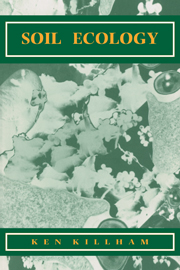Book contents
- Frontmatter
- Dedication
- Contents
- Foreword
- Introduction
- 1 The soil environment
- 2 The soil biota
- 3 Ecological interactions between the soil biota
- 4 The ecology of soil nutrient cycling
- 5 Ecology of extreme soil environments - soil water stress
- 6 Ecology of polluted soils
- 7 Manipulation of soil ecology - ‘soil biotechnology’
- References
- Further reading
- Index
1 - The soil environment
Published online by Cambridge University Press: 12 October 2018
- Frontmatter
- Dedication
- Contents
- Foreword
- Introduction
- 1 The soil environment
- 2 The soil biota
- 3 Ecological interactions between the soil biota
- 4 The ecology of soil nutrient cycling
- 5 Ecology of extreme soil environments - soil water stress
- 6 Ecology of polluted soils
- 7 Manipulation of soil ecology - ‘soil biotechnology’
- References
- Further reading
- Index
Summary
INTRODUCTION
Soil consists of mineral material, the roots of plants, microbial and animal biomass, organic matter in various states of decay, as well as water and a gaseous atmosphere. The uneven distribution of these components provides a great variety of conditions at all levels of scale from field to soil micropore, and sets a challenge to all those who sample the soil to study its composition and function. A whole spectrum of interacting physical and chemical factors contributes to the varied nature of the soil habitat, and hence determines the composition and activity of the soil biota at a particular site and time. This chapter presents the most significant of these habitat-determining soil factors, particularly at the microsite level, and considers some of their more important interactions.
THE SOIL AS A SOURCE OF ENERGY AND NUTRIENTS TO THE BIOTA
Different components (plant roots, microbes and animals) of the soil biota have different dependencies on the soil environment for their energy and nutrient supply. Plants and photoautotrophic microbes obtain their energy from sunlight, and also, along with chemoautotrophic microbes (energy from oxidation of inorganic compounds) acquire their carbon directly from the atmosphere largely as carbon dioxide. In addition, a number of specialised microbes and plant root/microbial associations are able to directly fix free atmospheric nitrogen. Apart from these obvious exceptions, the remaining soil biota obtain their energy and nutrients directly from the soil resource either from minerals, from organic matter or from other components of the living soil biomass.
Soil minerals as a source of nutrients
The soil biota obtain a significant proportion of their nutritional requirement from the weathering of soil minerals, predominantly secondary minerals. These secondary minerals, such as secondary silicates and oxides of iron and manganese, tend to be present in the fine silt and clay fractions of the soil. Nutrients from weathered minerals enter the soil solution and then reach the sites of biological activity through a combination of mass flow and diffusion.
In some cases, members of the soil biota accelerate the rate of mineral weathering, usually through the production of organic acids, thus encouraging mineral solubilisation. An example of this is the lichen association between an alga and a fungus, where the lichen thallus will often colonise and weather bare rock surfaces and hence initiate soil development.
- Type
- Chapter
- Information
- Soil Ecology , pp. 1 - 33Publisher: Cambridge University PressPrint publication year: 1994

